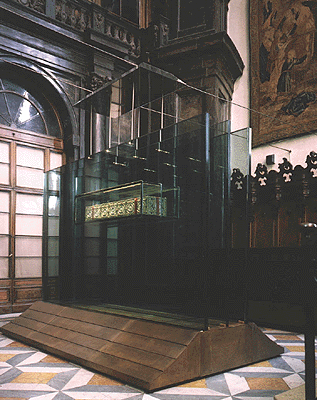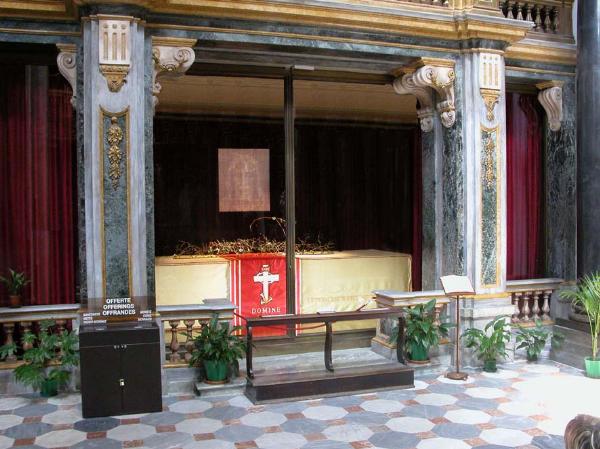The following is part 9, "2.3. The man on the Shroud" in my series, The Shroud of Turin The previous post in this series was part 8, "2.2. The Shroud's location " and the series' first post was part 1, the Contents page. See that page for more information about this series .
2. WHAT IS THE SHROUD OF TURIN?
2.3. THE MAN ON THE SHROUD
© Stephen E. Jones
Image of a man. As we saw in part 3, "1.1 Overview of the Shroud of Turin", the Shroud bears the faint[1] double image[2], front and back[3], head to head[4] of a naked[5],  bearded[6], muscular[7], tall[8], man [9].
bearded[6], muscular[7], tall[8], man [9].
Frontal image. On the frontal image the man's hands are crossed over his pelvis[10], covering his genitals[11].
[Right (click to enlarge): The frontal image on the Shroud[12]. For the full image, see part 3]
Wounds and bloodstains. He has wounds[13] and bloodstains[14] which match the Gospels' description[15] of the beating[16], crowning with thorns[17], flogging[18], carrying a cross[19], crucifixion[20], death[21], legs not broken[22], speared in the side[23], wrapped in a linen shroud[24], burial[25] and resurrection[26] of Jesus Christ[27].
Dorsal image The dorsal or back image of the man on the Shroud  shows multiple puncture wounds to the back of the head, evidently caused by a crown, or
shows multiple puncture wounds to the back of the head, evidently caused by a crown, or
[Left (click to enlarge): The dorsal (back) image on the Shroud[28].
rather cap of thorns[29]; over 100 small dumbbell shaped indentation wounds which correspond to those inflicted by a Roman flagrum on the back and legs[30], pooling of blood in the small of the back[31]. Only the image of the sole of the right foot is visible[32] and from it there is a blood flow evidently from a nail wound[33]. There is also dirt adhering to the footprint[34], which as we shall later see is very significant.
This will all be covered in more detail in "2.4. The wounds," "2.5. The bloodstains" and "3. The Bible and the Shroud."
NOTES
1. Wilson, I., 1979, "The Shroud of Turin: The Burial Cloth of Jesus?," Image Books: New York NY, Revised edition, p.21. [return]
2. Wilson, 1979, p.21. [return]
3. Antonacci, M., 2000, "The Resurrection of the Shroud: New Scientific, Medical, and Archeological Evidence," M. Evans & Co: New York NY, p.1. [return]
4. Wilson, I. & Schwortz, B. , 2000, "The Turin Shroud: The Illustrated Evidence," Michael O'Mara Books: London, 2000, p.18). [return]
5. Drews, R., 1984, "In Search of the Shroud of Turin: New Light on Its History and Origins," Rowman & Littlefield: Lanham MD, p.11. [return]
6. Guerrera, V., 2000, "The Shroud of Turin: A Case for Authenticity," TAN: Rockford IL, p.1. [return]
7. Wilson, 1979, p.21. [return]
8. About 181 cms or 5 ft 11 in. (Wilson, 1979, p.35). [return]
9. Wilson, 1979, p.21. [return]
10. Heller, J.H., 1983, "Report on the Shroud of Turin," Houghton Mifflin Co: Boston MA, p.vii. [return]
11. Wilson, I., 1998, "The Blood and the Shroud: New Evidence that the World's Most Sacred Relic is Real," Simon & Schuster: New York NY, p.56. [return]
12. Latendresse, M., 2010, ShroudScope: Durante 2002. [return]
13. Stevenson, K.E. & Habermas, G.R., 1981, "Verdict on the Shroud: Evidence for the Death and Resurrection of Jesus Christ," Servant Books: Ann Arbor MI, p.4. [return]
14. Iannone, J.C., 1998, "The Mystery of the Shroud of Turin: New Scientific Evidence," St Pauls: Staten Island NY, pp.2-3. [return]
15. Stevenson, K.E. & Habermas, G.R., 1990, "The Shroud and the Controversy," Thomas Nelson Publishers: Nashville TN, pp.84-88. [return]
16. Mt 27:30; Mk 15:19; Lk 22:63-64; Jn 19:3. Stevenson & Habermas, 1990, p.86. [return]
17. Mt 27:29; Mk 15:17-20; Jn 19:2. Stevenson & Habermas, 1981, p.122. [return]
18. Mt 27:28-29; Mk 15:17-18; Jn 19:2. Stevenson & Habermas, TN, 1990, pp.84-85. [return]
19. Jn 19:17; Mt 27:32; Mk 15:21; Lk 23:26. Stevenson & Habermas, 1990, p.86. [return]
20. Lk 24:39-40; Jn 20:20,25-27; Col 2:14. Guerrera, 2000, p.39. [return]
21. Mt 27:50; Mk 15:37; Lk 23:46; Jn 19:30. Stevenson & Habermas, 1990, p.87. [return]
22. Jn 19:30-33. Antonacci, 2000, p.120. [return]
23. Jn 19:34-35. Stevenson & Habermas, 1990, p.87. [return]
24. Mt 27:59; Mk 15:46; Lk 23:53; Jn 19:40. Guerrera, 2000, p.37. [return]
25. Mt 27:59-60; Mk 15:46; Lk 23:52-53; Jn 19:41-42. Stevenson & Habermas, 1990, pp.87-88. [return]
26. Mt 28:1-6; Mk 16:1-6; Lk 24:1-7; Jn 20:1-9. Stevenson & Habermas, 1981, p.156. [return]
27. Stevenson & Habermas, 1990, pp.83-99. [return]
28. Latendresse, 2010. [return]
29. Wilson, 1979, pp.36-37. [return]
30. Wilson, 1979, p.38. [return]
31. Wilson, I., 1986, "The Evidence of the Shroud," Guild Publishing: London, p.26. [return]
32. Wilson, 1979, pp.41-42. [return]
34. Wilson & Schwortz, 2000, p.93. [return]
To be continued in part 10, "2.4. The wounds".
Last updated: 27 February, 2013.






























